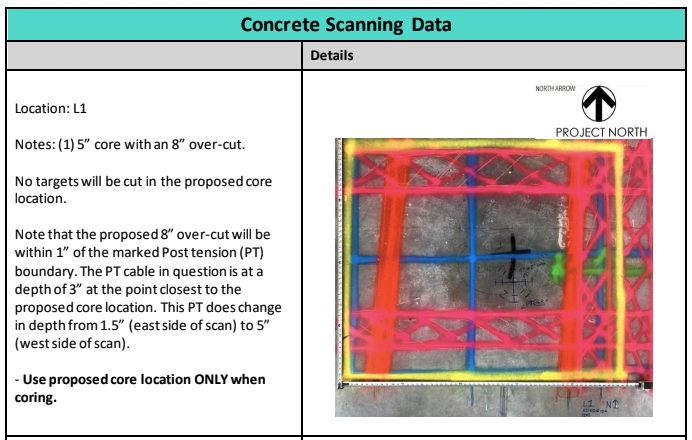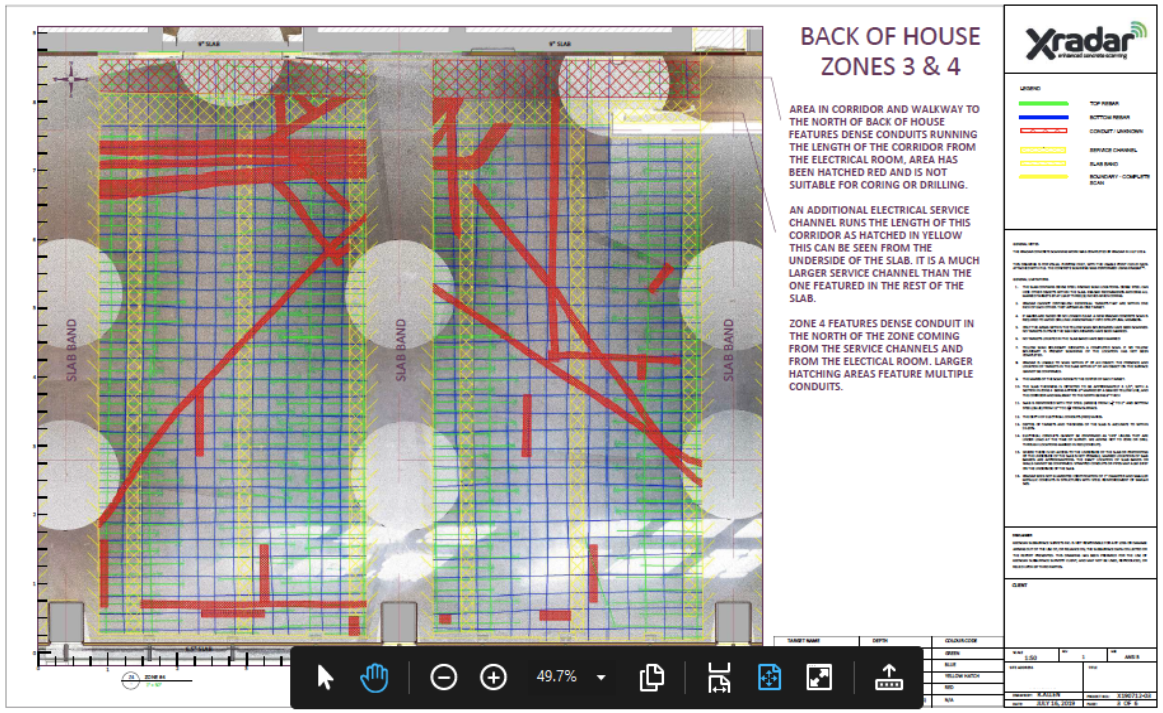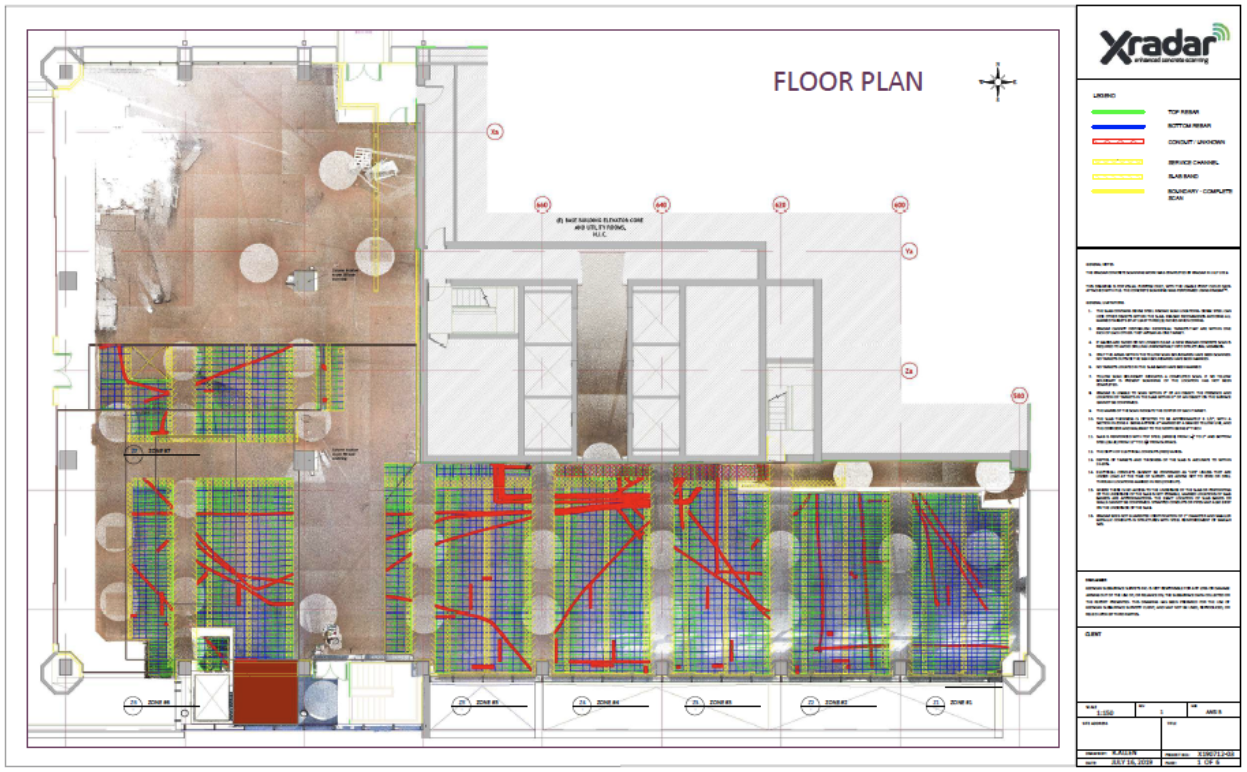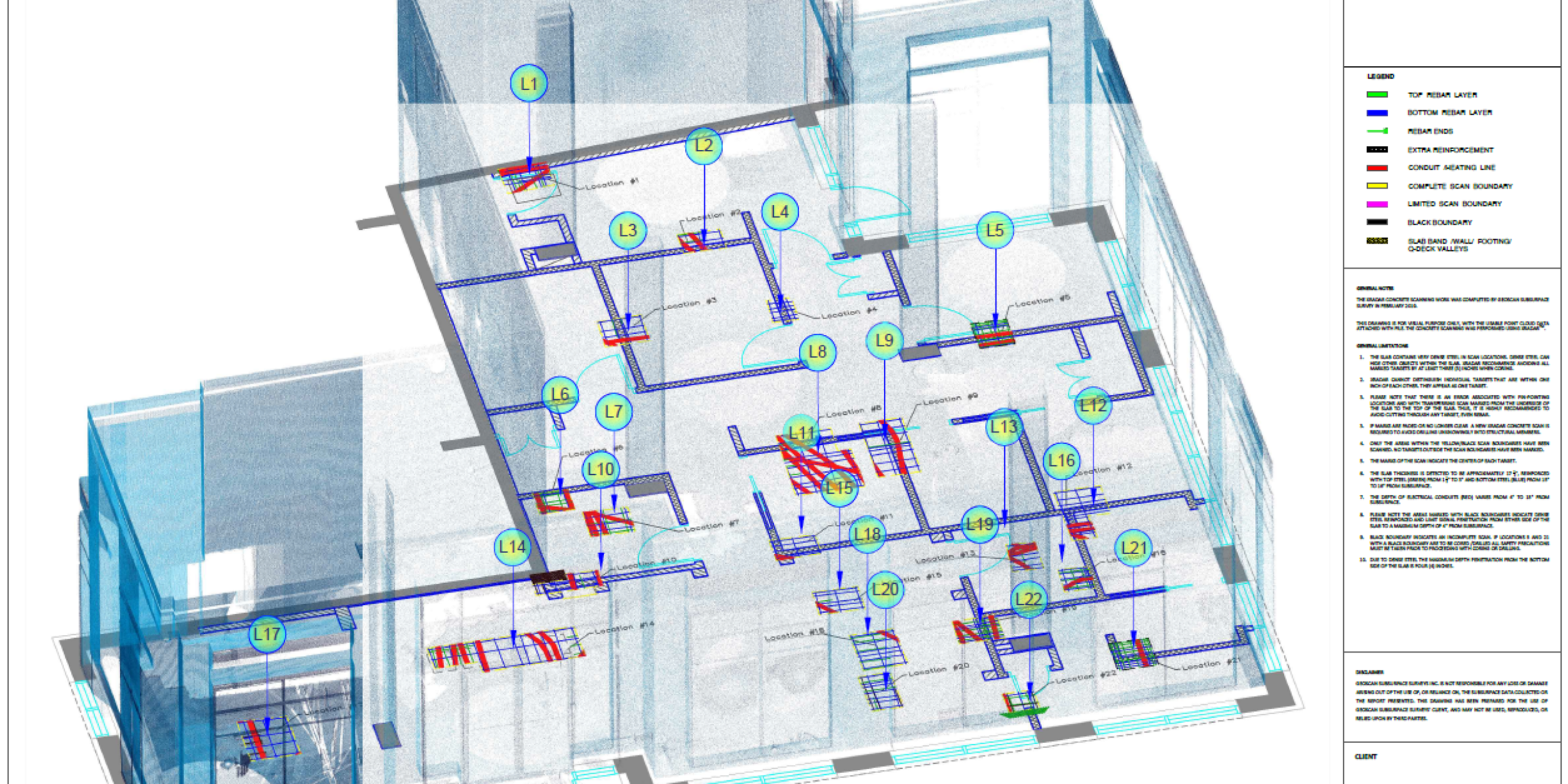
With the rapid development of Building Information Modelling (BIM) in the construction industry, concrete imaging and inspection companies have had to step up their game to create a comprehensive portfolio of reports. Our partners Xradar have done exactly this.
A variety of reporting levels are now available, so selecting a deliverable to suit scope and budget is easier and more accurate than ever.
This article outlines the options that are available to you, whether you are locating embedded objects before cutting concrete, performing a structural analysis of a bridge or building, or at the pre-design phase of a refurbishment.
Xradar has designed different concrete scan reports in order to cater to a wide variety of projects. Additionally, any survey can be tailored to match the particular needs of a client.
Services
- Forensic/Crime Scene Geophysics
- Construction Layout Surveys
- LiDAR Services & Mobile Mapping
- GIS Utility Mapping
- Topographic Surveys
- Surveying
- Underground Oil Tank (UST) Locating
- Subsurface Utility Engineering
- Utility Line Locating
- Tree Root Mapping
- Asphalt & Pavement Thickness Mapping
- Archaeological Geophysics
- Ice Thickness Profiling – Lake, River and Road
- Contaminant Plume Mapping & Landfill Delineation
- Bedrock Mapping & Profiling
- Subsurface Void Locating
Location
Vancouver
Industry
Engineering
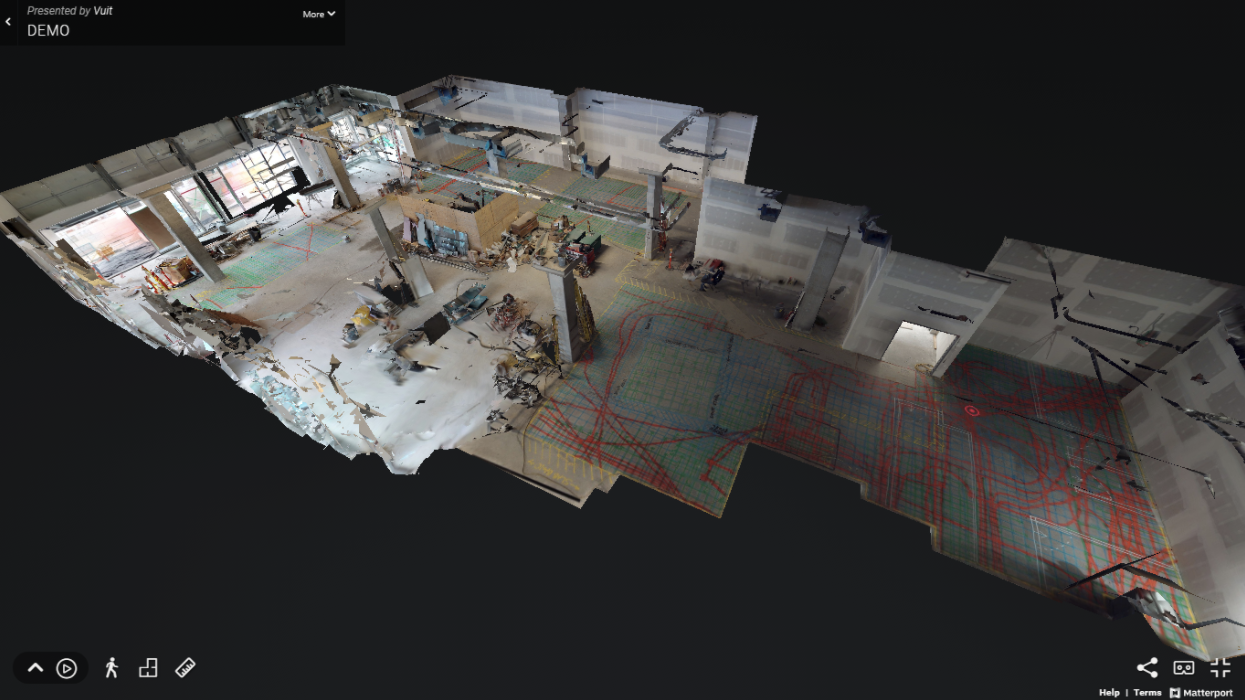
Example of a 3D point cloud: the user has full liberty to move around and rotate at 360-degree within the file
What is a concrete scanning report?
During a construction project, depending on the project itself, you will likely need to break ground. Therefore throughout the construction process there is the need for concrete scanning, primarily before any cutting, drilling, or coring.
Concrete scanning through the use of cutting edge technology in the hands of well trained technicians can ensure work is carried out safely, and without damage to objects beneath the surface, such as rebar and conduits.
When a concrete scan is completed clients are provided with a detailed concrete scanning report tailored to your needs, outlining the key information from our survey, allowing you to make informed decisions for your project.
What reports are available to me?
At Xradar for each project we typically provide one of four reports:
- Core approval report
- CAD report
- Structural investigation report
- Pre-design report
Each report is unique in its own way and the requirement is based upon the scope of the project itself. Here’s an in-depth description of each with reasons for and against its use for your project.
Xradar Core Approval Report
The Core Approval Report provides structural engineers the information they need to approve concrete drilling without the need for a site visit.
On completion of a scan, the technicians will mark out advised locations of core holes on the concrete, after discussion with the client and/or relevant contractors. Any objects that would be unavoidably cut during the coring process will be clearly identified on the concrete itself, as well as the report.
Within a Core Approval Report, there will be photos of the area accompanied by clearly scaled floor plans containing the appropriate markings for each target. The detail here allows for remote decision making by the structural engineer, which has been especially popular during the COVID-19 pandemic.
Xradar CAD Report
A CAD Report is one of the most comprehensive reports you will come across within the construction industry.
This report is designed specifically for engineer approvals and pre-design scanning using computer-aided design (CAD).
It includes a scaled AutoCAD drawing of the scanned areas, complete with a full written report highlighting the purpose of the survey, methods, theory, results, and limitations.
The report typically is delivered both in a PDF format and the AutoCAD raw files, but in the case of Xradar there is the option to include 3D point-cloud data to enable you to experience a Virtual Walkthrough.
Xradar Structural Investigation
Good as-built drawings for concrete structures will detail concrete thickness, minimum reinforcement cover and foundation locations, as well as intended slab thicknesses, average rebar spacing and location of beams. However this generally never the case, particularly with older buildings and hence concrete scanning is required.
A structural investigation will provide extensive information about any concrete structure and Xradar has the capability to provide estimates of rebar diameter sizes.
With a thorough structural investigation it is possible for structural engineers to analyse the information to create detailed or update existing as-built structural drawings for analysis, load-bearing calculations and design considerations.
This report can also be delivered either as AutoCAD drawings or 3D point-cloud design if required.
Pre-Design Concrete Scanning
Pre-design surveys are aimed at tackling a problem contractors often face during construction, when design commitments have been made before knowing the contents of the slab.
Pre-design scanning is therefore now a regularly used method of risk mitigation in projects that allow time to do it.
An inability to plan in advance often means you can’t core holes where intended because of conflicts with slab bands, conduits or other objects within the slab. This is largely due to the fact that the space has been designed without any prior knowledge of the concrete and the disposition of conduits and steel reinforcement.
Instead, you could involve a concrete scanning company in the earlier stages of a project.
Concrete scanners will produce detailed mapping of all embedded objects in the slab, marked in real-time and the space can be designed to minimize or greatly reduce conflicts during construction.
In addition to CAD drawings, this report is also delivered in the form of an interactive site walkthrough. Engineers and designers can visualise the space as they draw their plans.
How do I decide on which report type I need?
It’s extremely important that you are comfortable with the report that you have settled on for your project. In doing this you have to understand what you hope to achieve.
Are you hoping to gain insight into rebar sizing, or potentially load bearing capacity? Then you may require a Structural Report.
Are you in the process of a design layout change or wishing to make many holes into concrete on a particular floor? You should consider a Pre-design Report.
Many concrete scanning technicians offer a consultation stage within their process, which allows the client to discuss the requirements with trained professionals, building the scope and agreeing the deliverables. In Xradar’s case, this is performed by our dispatch and account management team. You can contact them here.
What happens once I’ve decided on a report type?
When the client has decided on a service and report type, the scanning technicians will come to site and scan all determined locations using top of the line GPR scanning units.
Xradar technology enables the scanning technician to easily differentiate between steel reinforcement, plastic conduits and post-tension cables. All embedded objects are then accurately identified and marked on the ground itself.
Once the concrete scanning survey has been completed, scan marks will be captured using 3D laser cameras and the data can be processed to create as-built drawings as well as a digital representation of the space. With 3D laser scanning, the accuracy of measurements are unparalleled. This greatly facilitates the designing process and allows the client and its team to evaluate options with accurate as-built models and real world conditions.
What is ‘Xradar Technology’?
Xradar™ is a newly designed and developed technique for scanning concrete, with the accuracy of X-ray but the safety and efficiency of GPR. Xradar uses modified technology and enhanced methods to obtain more information from data that an off-the-shelf GPR might provide.
The modified technology gives Xradar Technicians an ability to see through dense steel reinforcement, tight rebar, or mesh.
Xradar has the knowledge and experience required to scan any kind of slab that they might encounter on site. Technicians have been trained to scan the most difficult of slabs and are able to clear concrete up to 24” thick with double-sided scanning.
Every service offered is created with a focus on streamlining the concrete scanning and coring process. The goal is to find the most efficient solution in every instance and to save the client, time and money.
If you have an upcoming project with concrete scanning involved, Xradar’s team will gladly guide you towards the right reporting solution.
If you’re further along the process and are looking into coring holes, check out our concrete coring service.
